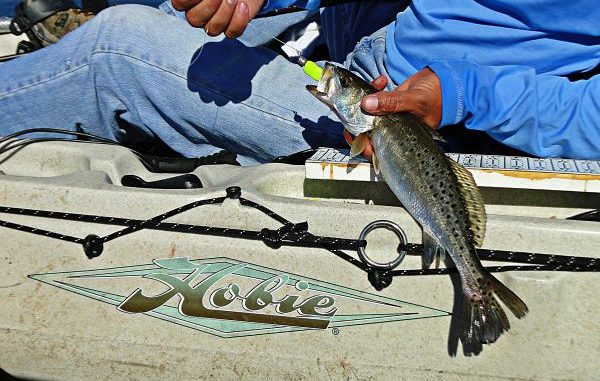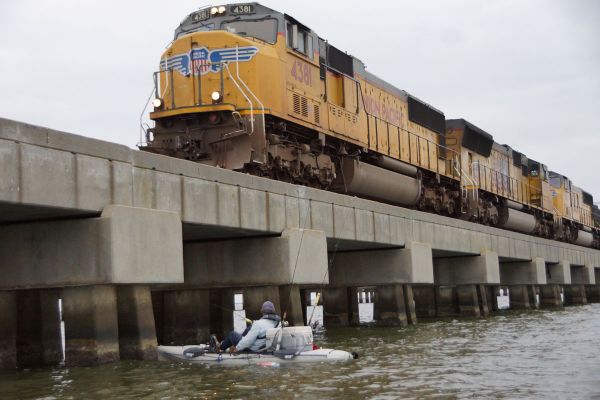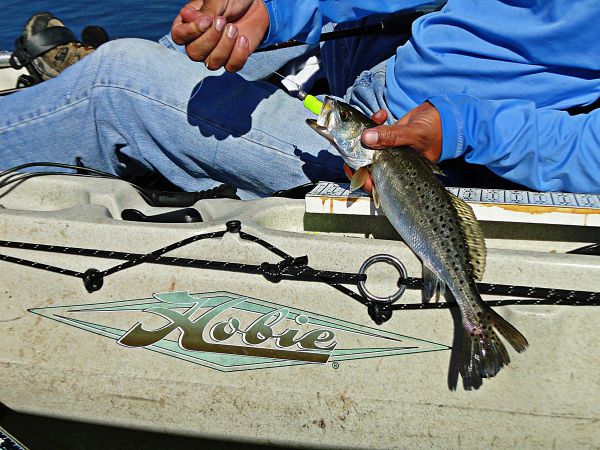
Trout gang up on pilings, reefs this month
Lake Pontchartrain is legendary for its fall run of speckled trout. With miles and miles of bridge structures and some artificial reefs, there’s no shortage of locations to get on a hot bite.
And the best news of all is that it can be done with plastics — both baits and boats.
Before any discussion begins about kayak fishing in Lake Pontchartrain, safety must be the first order. The lake is big water, and can be both productive and dangerous. Pick your days and take no chances with the weather.
The good news is that fall weather is not plagued with pop-up thunderstorms and you can predict the weather conditions fairly well before you go. Stay away from frontal systems, and you will have a safe and pleasant day on the water.
Live-shrimp season is now open year round. If the fall/winter is mild, shrimp stay in the inside waters and can be caught and sold for live bait. If shrimp are there, you can bet trout and redfish will be feeding on them.

However, although live bait might be available, plastics are all you really need.
While kayak anglers certainly catch their share of trout throughout the summer, redfish are generally more accessible to them at that time. The spring and summer spawning season often finds the trout in areas too far to reach by kayak.
However, ’yakers get giddy as the trout transition back into the interior lakes and marsh as the water temps begin to cool.
And smack in the middle of the New Orleans metropolitan area sits Lake Pontchartrain. Known for its annual fall run of fat speckled trout, the lake is easily kayak accessible from all directions. In many areas, kayakers can launch and be fishing in under five minutes.
Although spring and summer trout fishing on Lake Pontchartrain this year was all but nonexistent, the fall season is looking much better. Heavy rains and high rivers earlier this year kept salinity levels down and prevented the brown shrimp crop from entering the lake. No fish food, no fish. There were a few short spurts of good trout catches, but overall the early season was considered a bust.
But with the rivers down and a late-season tropical storm providing a surge of salty Gulf water, the lake is shaping up for a banner late-year run of trout. Salinity levels are rising, and reports of catches of quality trout are now coming from the area bridges — and even the Seabrook.
Counting the north- and southbound lanes of the Causeway and Twin Spans, as well as the Highway 11 bridge and the Trestles, there are over 80 miles of pilings that provide prime fish-holding structure. Add that to the several artificial reefs in the lake and there is clearly no shortage of areas for kayakers to set up shop.
Anchoring, trolling or drifting near any of these fish-holding magnets will have you doing battle with hungry trout. Tide times and ranges are difficult to accurately predict for Pontchartrain; with the vast size of the lake and the influences of several passes and the wind, even veteran lake fishermen have difficulty predicting exact tide conditions.
As always, fishing when the water is moving one way or the other is generally most productive.
Some days the trout in Pontchartrain will be holding tight to the bridge pilings or even under the bridge. However, sometimes they will be found many yards out, away from the pilings. Tight-lining or Carolina rigging are the preferred methods for fishing the bridge structures.
Trolling up and down the bridge spans also works well if the crowd is not too thick. Depending on the current, jigheads from ¼ up to ½ ounce can be necessary to get your plastic bait to the bottom.
The bites are often subtle and difficult to feel, especially if the tide is moving your bait toward you. Having fished the lake several times with legendary Lake Pontchartrain charter captain Dudley Vandenborre, “line watching” is often the key to detecting a bite. No one does this better than Dudley.
By paying attention to where your line enters the water, you can see that erratic or unusual twitch that signals a bite even though it’s not transferred back to your rod. See something, set the hook.
 The key to fishing the bridges is to fish all sides and all angles. Take note of how and where you catch a fish. That will likely be the prevailing pattern for the day, and you can repeat the procedure to work your way toward a limit.
The key to fishing the bridges is to fish all sides and all angles. Take note of how and where you catch a fish. That will likely be the prevailing pattern for the day, and you can repeat the procedure to work your way toward a limit.
There are two kayak-accessible reefs located between the Twin Spans and Highway 11 bridge. The reefs consist of crushed rock and concrete. It’s difficult to bottom-fish on top of the reefs without getting snagged. However, savvy reef fishermen use a sliding cork to get their lures close to the bottom just above the fish-holding surface of the reef.
To access the Twin Spans, Highway 11, Trestles and the artificial reefs, there are free launches near the base of Highway 11 on both the north and south shores of the lake. The one on the north shore is an old back-down ramp and on the south shore, there is a sandy, “combat” launch area.
The Causeway can be accessed on the south shore by launching at the Bonnabel boat launch and paddling about a mile over to the Bridge. A new kayak launch at Lake Pontchartrain Harbor offers an easy five-minute paddle to the Causeway Bridge; the private launch costs $35 a year for an unlimited permit that also allows ’yakers to primitive camp on the lake’s shoreline.
There are other areas to launch a kayak on all sides of Lake Pontchartrain. And the bridges and reefs are not the only productive fishing areas.
Kayakers are advised to check the fishing reports on Louisianasportsman.com. Chances are that you will be able to access most of the same spots where boat fishermen are having success on the lake.
Get your plastic boat and plastic baits together, and make a quick, economical and successful kayak trip onto Lake Pontchartrain.
